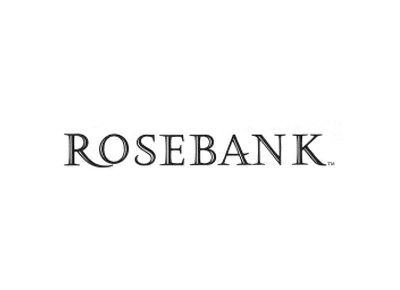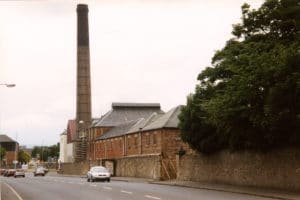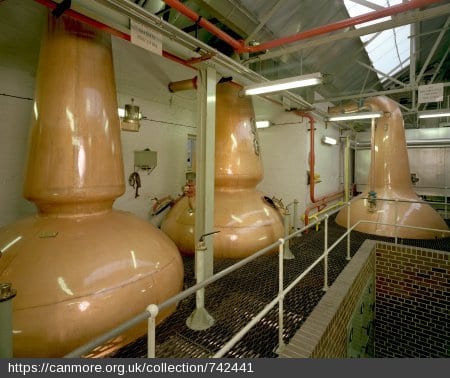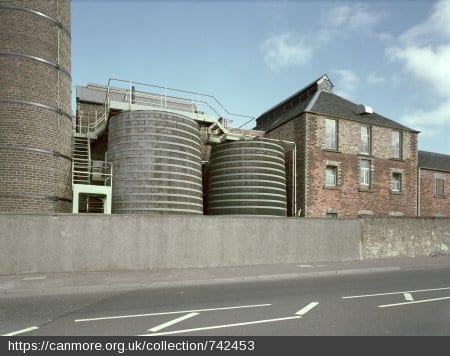Rosebank distillery information
The years is 1798, and the Stark Brothers decide to start distilling whisky. They start off in the town of Camelon between Edinburgh and Glasgow. It is unknown whether this was at the location of what would later become known as the Rosebank distillery. Little information about their operation is available, so chances are it was not exactly a legal process. In 1817, a distillery was founded by James Robertson located right next to the Forth and Clyde canal. It operated under the Rosebank name, which it took from the roses growing on the banks of that canal. The distillery was only active until 1819. In 1827, one of the Stark brothers, John, opened up a distillery of his own. This one was located on the opposite western side of the canal in 1827, and operated under the name Camelon.
Camelon was managed by John until he passed away in 1836, leaving it in the care of Thomas Gunn and his father. Around 1840, a gentleman called James Rankine purchased the malting floors, which were on the East side of the canal. Rankine was a local grocer with an interest in wine and spirits, who went on to set up a whole distillery of his own using the Rosebank name. The distillery expanded shortly after, but fell silent between 1862 and 1864, when major refurnishing, modernisation and rebuilding took place.
New ownership
The Camelon distillery was forced to close when the company went insolvent in 1861, allowing Rankine (by then the son R.W.) to purchase the property. He promptly had it torn down to make room for a new malting floor, using a bridge across the canal to move the malted barley from the floors to the distillery.
Rosebank Distilleries Ltd was established in 1894, with Rankine owning half the shares. Another round of stocks was issued in 1897. Rosebank was hit quite hard by the Pattison Crash of 1900, and was forced to scale back production.
By 1914, Rosebank, together with the Clydesdale, GlenKinchie, Grange and St. Magdalene distilleries formed Scottish Malt Distillers (which later would be absorbed by Distillers Company Limited, which would merge into United Distillers, and eventually Diageo). The distillery was forced to close briefly while WW1 raged, but otherwise produced spirit at a steady rate, until its mothballing in 1993. The closing was a tactical move by Diageo, as the distillery was in need of modernisation. Apart from that, the site at the canal where the distillery was located hardly was a touristy place, and it was poorly accessible by road. The final nail in the coffin might have been that relatively close-by GlenKinchie was a very pretty distillery with a much larger capacity.
Rosebank no more
The distillery was sold to British Waterways Board in 2002, who demolished the malting floors in order to develop apartments on the site. A restaurant was established in one of the former warehouses. The closing of Rosebank greatly annoyed a number of whisky enthusiasts, who had grown quite fond of its produce. Plans to relaunch Rosebank with its original equipment pretty much never died. Unfortunately, in 2009 news hit that the stills, mash tun as well as other equipment had been stripped by metal thieves.
2017 revival
In October 2017, Ian Macleod Distillers (owners of Glengoyne, Tamdhu and Smokehead) announce that they purchased the Rosebank name and remaining stock from Diageo. They plan on re-opening the iconic distillery on its former site, having secured that from Scottish Canals. The intention is to reopen in 2019.
Rosebank Whisky
The whisky produced at Rosebank was a typical Lowland style, and was triple distilled. Once distilled, it was run through gigantic wormtubs located on the outside of the distillery. The resulting spirit was fruity, flowery and very smooth. It proved to be very popular as a single malt, and there have been a large number of independent bottlers who released spirits from Rosebank. Some official releases included:
- Flora and Fauna – 12 Year Old
- 12 Year Old
- 20 Year Old (Rare Malt)
- 22 Year Old (Rare Malt)
- 25 Year Old (Distilled in 1981, bottled in 2006)
- 21 Year old (distilled 1990, bottled in 2011. 53.8% ABV)
Distillery info:
| Name | Rosebank |
| Region | Lowland |
| Logo |  |
| Status | Closed |
| Founded | 1798 |
| Water source | Carron Valley Reservoir |
| Owned by | Diageo |
| Address |
Falkirk |
| Visitor centre | No |
| Website | https://www.rosebank.com/ |
| N/A | |
| N/A | |
| Community | N/A |
| Map |
Distillery Setup:
Component |
Capacity |
Quantity |
|---|---|---|
| Mash tun | ? | 1 |
| Washback | 3,500 gallons litres | 8 |
| Wash still | 3,000 gallons litres | 2 |
| Spirit Still | 1500 gallons litres | 1 |
| Expected yearly output in LPA (Litres of pure alcohol) | 560,000 |



Leave a Reply